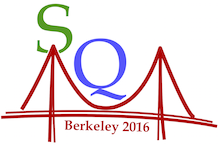Conveners
Quarkonia II
- Andre Mischke (Universiteit Utrecht)
Orlando Villalobos Baillie
(University of Birmingham (GB))
30/06/2016, 11:00
Contributed Talk
Ultra-Peripheral Pb-Pb collisions, in which the two nuclei pass close to each other but at an impact parameter greater than the sum of their radii, provide information about the initial state of nuclei. In particular, J/psi production, where the particle mass sets a hard scale, proceeds in such collisions by photon-gluon interactions, and gives access to nuclear PDFs. The ALICE collaboration...
Antoine Lardeux
(CEA/IRFU,Centre d'etude de Saclay Gif-sur-Yvette (FR))
30/06/2016, 11:20
Contributed Talk
Heavy quarkonium states are expected to provide essential information on the properties of the deconfined state of nuclear matter, the Quark-Gluon Plasma (QGP), formed in the early stages of ultra-relativistic heavy-ion collisions.
In particular, the suppression of the strongly bound quarkonium states via the color screening mechanism can be seen as an effect of deconfinement.
Furthermore, a...
Chad Steven Flores
(University of California Davis (US))
30/06/2016, 11:40
Contributed Talk
Bottomonia are important probes of the quark-gluon plasma (QGP) since they are produced early on and are expected to be suppressed due to color deconfinement. They are also considered to be a cleaner probe than charmonia due to the lack of regeneration even at the LHC. The ratio of excited states Y(nS) measured with respect to the ground state Y(1S) in both pp and PbPb collisions are combined...
Pol Gossiaux
(Subatech)
30/06/2016, 12:00
Contributed Talk
The suppression of upsilon Y(1S) states in AA collisions, observed by the STAR collaboration at RHIC and by the CMS and ALICE collaboration at LHC, is one of the most convincing evidence for the creation of the quark gluon plasma. The precise survival of excited Y(2S) and Y(3S) states vs ground state could even allow to measure the highest temperature reached in those collisions, according for...
William King Brooks
(Federico Santa Maria Technical University (CL))
30/06/2016, 12:20
Contributed Talk
Photons and weak bosons do not interact strongly with the dense and hot medium formed in the nuclei collisions, thus should be sensitive to the nuclear modification of parton distribution functions (nPDFs). The in-medium modification of heavy Charmonium states plays an important role in studying the hot and dense medium formed in the larger collision systems. The ATLAS detector, optimized for...
